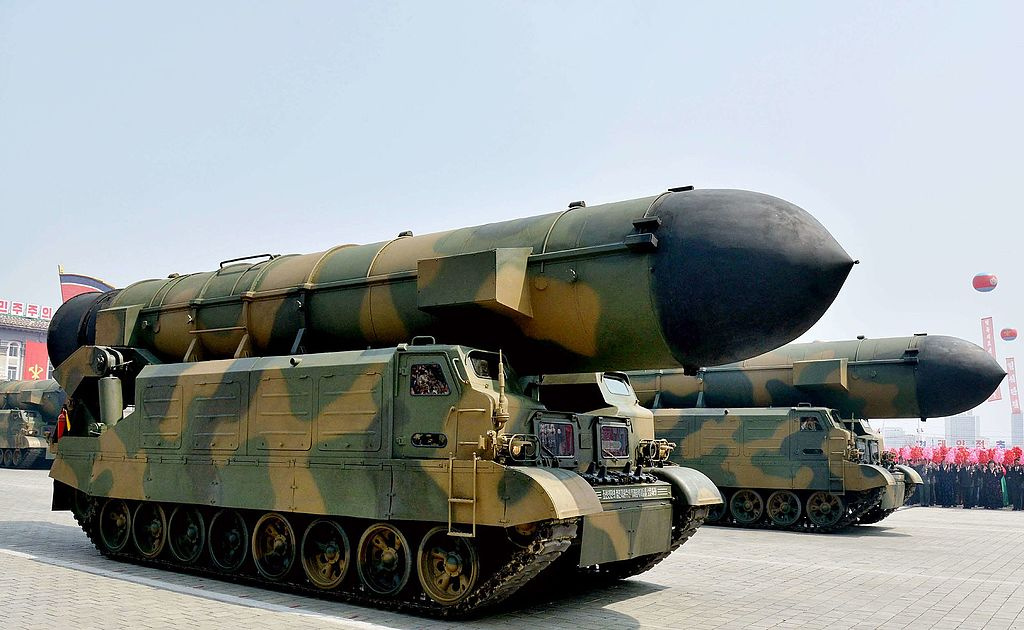America’s Missile Defenses Against North Korea Have a Big Problem (They Only Work Half the Time)
The conventional wisdom used to be that once an intercontinental ballistic missile shoots off from its silo into the exosphere, the best you could do was brace yourself for a mushroom cloud. There was simply no defense that could conceivably shoot one down.
However, the United States today possesses a potential ace in its hand to defeat such an attack—or, more precisely, thirty-six aces. Were North Korea to fling a ballistic missile across the Pacific Ocean aimed at the continental United States, then the U.S. Missile Defense Agency’s Ground-based Midcourse Defense (GMD) interceptors would attempt to knock them out of the sky.
The GMD system’s ability to potentially destroy an ICBM is exceptionally rare. But Washington shouldn’t grow overconfident about its ballistic-missile shield: it is only designed to protect against very limited-scale attacks. Furthermore, the interceptors so far have, when tested, only hit their targets about half the time.

Back in the 1980s, Reagan envisioned developing a comprehensive missile shield that would protect America from attack. However, the “Star Wars” Strategic Defense Initiative ran into the problem that it was expensive to improve a defensive system, and relatively cheap to improve ICBMs with decoys and multiple independently targetable reentry vehicles to overwhelm the defenses.
By the 1990s, a less ambitious idea known as Global Protection Against Limited Strikes had emerged. The Pentagon recognized it could not develop a defensive system that could handle the massive numbers of nuclear missiles in the Russian and Chinese arsenals. The new idea was to develop a much more limited defense in the event that the so-called rogue nations of the day—Iran, Iraq and North Korea—threatened the United States with a small number of domestically produced ballistic missiles. This developed into the prototype National Missile Defense system.
In 2001, the George W. Bush administration committed itself fully to the thinking behind NMD, announcing the United States’ withdrawal from the 1979 Anti-Ballistic Missile treaty—which had limited the deployment missile defense for the fear they would lead to an ever-escalating arms race—and created a new Ballistic Missile Defense Agency. NMD was renamed to its current GMD acronym, and rushed into production at the expense of the usual testing and procurement process.
The majority of missile defenses system today, including the THAAD system deployed to South Korea, are “terminal approach” defenses that can only shoot at ballistic missiles once they begin their descent towards the target. Unfortunately, larger, higher-flying intercontinental ballistic missiles (ICBMs) may simply move too fast on their descent for these systems to hit them. Furthermore, terminal-approach defenses can only protect a limited geographic area.
GMD is one of only two operational midcourse ballistic-missile interceptors that can tackle ICBMs; the other is the Israeli Arrow-3. A midcourse intercept can take out ballistic missiles in the exosphere—after they have expended their rocket fuel, but before they have begun their descent on the target. This allows the GMD interceptors to provide continent-wide defense and affords the defenders up to twenty minutes’ time to intercept the incoming ICBMs.
The present GMD system is based on several dispersed components. First, satellite-based infrared sensors detect the heat flash from the launch of ICBMs from orbit, and cue ground-based surveillance radars to track their trajectory. A ground-based battle-management center gathers sensor data from various sources and can ready the interceptors for launch. The interceptors will be guided towards their target by a precise X-Band targeting radar. Currently, the radar in question is a truly bizarre-looking Sea-based X-Band radar that floats atop a massive 115-by-85-meter submersible platform. Mounted atop it is the largest X-Band radar ever.
A sixty-foot-long GMD interceptor soars towards the ICBM powered by a three-stage solid fuel rocket, at speeds approaching four miles a second. Once all three rockets have exhausted their fuel, a 164-pound Exoatmospheric Kill Vehicle detaches from the booster. The EKV mounts small maneuvering thrusters to precisely guide itself onto a collision course with the incoming ballistic missile. The resulting impact at enormous speeds suffices to annihilate an ICBM.
This is known as “hit-to-kill” technology, because the GMD interceptors economize on weight by doing away with explosive warheads. However, due to the absence of a blast effect, a hit-to-kill missile must have very high degree of precision to ensure that it intersects in time and space with the target.
You can see a successful test interception by the GMD system here:
Currently, GMDs are stationed in two locations: thirty-two in Fort Greely, Alaska as part of the Forty-Ninth Missile Defense Battalion, and four in Vandenberg, California, in the Hundredth Missile Defense Brigade. Eight additional interceptors entering service this year should increase the total to forty-four. So far the GMD program has cost the United States nearly $41 billion as of 2017, and each interceptor is estimated to cost $75 million each.
Source:nationalinterest.org